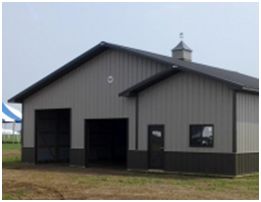Eight Nifty Tricks to Save Money When Building a Pole Barn (reprised)
Bret Buelo of Wick Buildings® wrote an article by this title last year, some of the items I agree with, some not so much. I will offer my “take” on his points.
“1. Spacing of your columns. Builders typically space columns anywhere between six and 12 feet. The wider your column spacing, the less costly your structure is going to be because each column and accompanying truss costs you money.
But some builders may lack the engineering knowledge to design the columns, trusses and the rest of the structure to the load requirements needed for your building. They’ll place columns every eight feet. And guess who ends up footing the bill?
Reduce the number of columns, and you’ll also need less trusses.”
The number of columns and trusses in any given building are a feature, not a benefit. The benefit being the ability of any given system to be able to adequately carry the imposed loads. In many load cases, the most cost effective column and truss spacing is indeed going to be 12 feet on center. https://www.hansenpolebuildings.com/blog/2011/06/pole-barn-truss-spacing/
Carrying this further, most builders lack the sufficient structural knowledge to adequately and efficiently design any portion of a post frame (pole) building. While their philosophies may “sound good” – they are unable to prove what they design with calculations and code conforming support.
“2. Choose durable materials. Saving money up front by purchasing less expensive materials isn’t always good in the long run. Ideally, you want to use materials that will last as long as your building does to avoid renovation costs.
For example, purchasing an inexpensive, low-quality door may end up costing more if you have to replace it within 10 to 15 years if the frame disintegrates, door warps or hinges bend.
This is a rule of thumb for nearly every purchase you make for your building— from windows and doors to steel and insulation materials. Cheap materials up front will always lead to higher maintenance, replacement and heating/cooling costs in the long run.”
I couldn’t agree more. In my mind, one of the core responsibilities of high quality post frame construction is to provide a building which requires little or no maintenance.
The most common materials’ error I see is selecting poor quality entry doors.
Wood doors – don’t even go there. Every “big box” or local lumberyard will happily sell an insulated steel entry door for $139-179. What they do not tell you (or you may not notice) is the perimeter of the door is wood, the steel part is a skin applied over an insulated core, with a wood framework. When the wood gets damp (which it will – this is an exterior door), it will begin to decay. The steel skins are white. Primer white. Most often they include a sticker which tells the end user the door must be painted within a very short time frame (probability of the door being painted? About equal to the Chicago Cubs winning the World Series). Adding insult to injury, these doors come with unpainted wood jambs.
More often than not, most of the decisions to use lesser quality materials are made by builders. Read more here: https://www.hansenpolebuildings.com/blog/2012/06/builder-grade/
“3. Install wainscot. This is a significantly overlooked but important piece to any post-frame building. Wainscot is a 3.5 foot steel panel placed at the bottom of the building. It is usually a different color but can also be the same color as the rest of the wall.
While it will cost you a small amount up front, your wainscot will act as a buffer if you accidentally bump into the wall of your pole barn with a lawnmower, tractor or truck.
Another common problem is your mower may kick up stones or sticks, shooting them at your building and scratching or denting the panel.
If an accident happens, instead of replacing the entire length of the sidewall, you would only have to replace the 3.5 foot section of steel — your wainscot.”
I agree 100% with this. Besides the functionality of wainscot, it also affords aesthetic value. With taller buildings, it keeps the structure from appearing to be as tall as it actually is. We can ship a 3’ piece of wainscot by FedEx or UPS, but not a longer wall piece. Not to mention the hassle and expense of the longer steel panel.
 “4. Choose building aesthetics wisely. Talk to your builder about ways to dress up your building without adding much cost. For example, consider a double gable to get a more residential look instead of shelling out for expensive siding or roof materials.”
“4. Choose building aesthetics wisely. Talk to your builder about ways to dress up your building without adding much cost. For example, consider a double gable to get a more residential look instead of shelling out for expensive siding or roof materials.”
I totally agree with choosing building aesthetics wisely. In my humble opinion, if a feature doesn’t have a benefit, I’d have a real difficult time recommending it. The proposed “double gable” solution, feels like a totally non-functional upgrade. However if you end up with a building where you dislike the overall looks of it, the money savings was not worth it. This is a judgment each person has to decide for him or herself – what cost is worth the final appearance?
Come back tomorrow – where I discuss sliding doors and other suggested money saving “tricks” by Bret Buelo…and my personal recommendations in Part II of a two part series on pole barn money savings.






